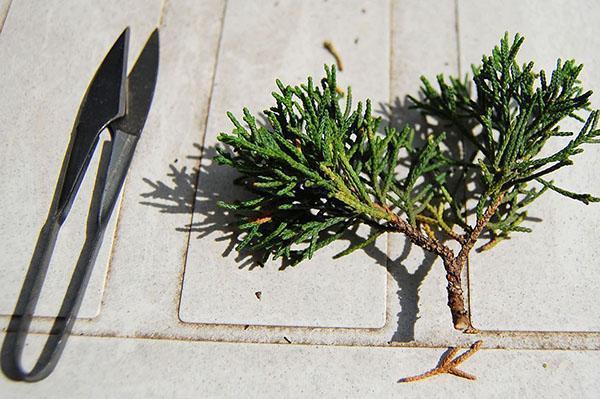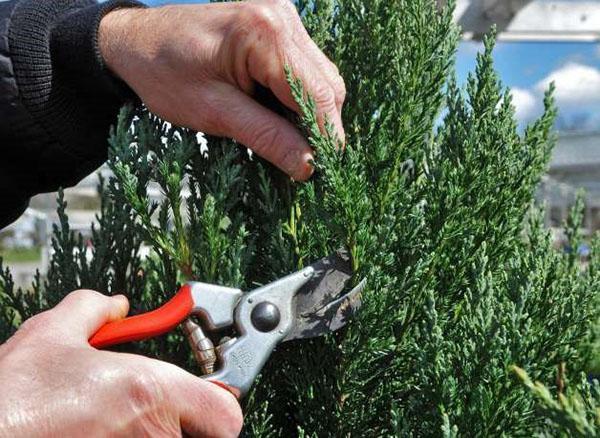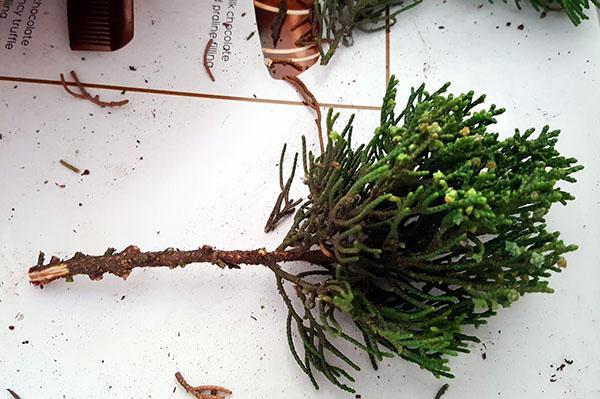Learning how to independently propagate juniper cuttings
 Juniper is a popular coniferous culture for decorating a garden or park. Reproduction of juniper by cuttings in spring allows you to get strong young plants most quickly and easily.
Juniper is a popular coniferous culture for decorating a garden or park. Reproduction of juniper by cuttings in spring allows you to get strong young plants most quickly and easily.
Features of the structure and reproduction of juniper

Due to the peculiarities of the structure and reproduction of juniper in nature, these plants are difficult to renew, and in nurseries and in ordinary summer cottages, vegetative methods are used to obtain new specimens.
However, you must remember that juniper shoots have an interesting feature. Even after rooting, becoming independent plants, they retain the "habits" obtained on the parent bush. Juniper shoots, located in the upper, central part of the crown, tend to develop, grow up. The peripheral branches eventually turn into bushes with a spread, squat crown.
At home, there are many advantages to propagating juniper by cuttings. Plants obtained in this way:
- retain all varietal properties of the parent specimen;
- 2–3 years earlier than seedlings, they reach the size of an adult shrub;
- better adapted to local conditions than large nursery seedlings;
- in comparison with seedlings, they show better growth rates.
When and how to prepare planting material? What is needed for rooting a juniper, and what are the features of caring for seedlings?
How to propagate juniper cuttings in spring
 You can cut a bush from early spring, that is, from the time of cutting the plant, and until autumn. However, experienced gardeners prefer to harvest cuttings in the spring, when there is a feast of growth. From April to May, semi-lignified shoots are cut from the already formed part of the crown with a sharp knife so that a thickened base of the branch remains on the cutting.
You can cut a bush from early spring, that is, from the time of cutting the plant, and until autumn. However, experienced gardeners prefer to harvest cuttings in the spring, when there is a feast of growth. From April to May, semi-lignified shoots are cut from the already formed part of the crown with a sharp knife so that a thickened base of the branch remains on the cutting.
The lower part of the cutting by 3-4 cm is cleaned of lateral shoots and needles, and then the exposed tip is treated with a root formation stimulator. Immersion of the cuttings intended for propagation of juniper in a jar of water with a little sugar added to it gives good results. In a day, future seedlings can be transferred to a previously prepared soil mixture.
Ephedra roots will develop faster and best in an aerated, loose substrate of equal parts of sand and peat... Perlite and crushed charcoal can be added to the mixture. The shrub is not afraid of the increased acidity of the soil, so there is no need to deoxidize it.
 Before propagating a juniper in the spring with cuttings, a small greenhouse or film greenhouse should be organized on the site or at home. Well-lit places are suitable for the plant, where cuttings will not be afraid of delusion due to stagnant moisture and cold wind. With due diligence, the shrub forms roots even in a pot covered with a bag.
Before propagating a juniper in the spring with cuttings, a small greenhouse or film greenhouse should be organized on the site or at home. Well-lit places are suitable for the plant, where cuttings will not be afraid of delusion due to stagnant moisture and cold wind. With due diligence, the shrub forms roots even in a pot covered with a bag.
 Cuttings are planted in separate pots or in a common container at a distance of 5–8 cm from each other, at an angle to the ground. The planting material is buried 3-4 cm, that is, no more than the length of the part of the shoot cleared of needles. After planting, the soil near the cuttings is compacted and watered abundantly.
Cuttings are planted in separate pots or in a common container at a distance of 5–8 cm from each other, at an angle to the ground. The planting material is buried 3-4 cm, that is, no more than the length of the part of the shoot cleared of needles. After planting, the soil near the cuttings is compacted and watered abundantly.
Juniper loves light, but direct sunlight inhibits the development of the seedling. Therefore, shading should be provided for the greenhouse.
Care of cuttings during spring reproduction of juniper
 Further care for the cuttings during the reproduction of juniper in the spring consists in regular spraying with warm settled water and ventilation as moisture evaporates from the soil surface. Excessive soil moisture is dangerous! The fragile root system of a juniper can rot and the plant will die. Airing will help balance the humidity in the air and prevent condensation.
Further care for the cuttings during the reproduction of juniper in the spring consists in regular spraying with warm settled water and ventilation as moisture evaporates from the soil surface. Excessive soil moisture is dangerous! The fragile root system of a juniper can rot and the plant will die. Airing will help balance the humidity in the air and prevent condensation.
A detailed video on how to propagate a juniper by cuttings will help you not to make mistakes and independently get strong planting material for your summer cottage.
The rooting of most varieties of this coniferous crop takes at least 50–90 days. However, one should not rush to planting shrubs for permanent residence.
Usually, seedlings are left at home or in a greenhouse until next spring, or transferred to open ground with a lump of earth to protect the not too branched and strong roots from damage. Such plants must be covered for the winter and protected from the penetration of rodents.
The time for planting juniper is chosen so that young shrubs have time to adapt before the arrival of cold weather. If in the spring the cuttings for reproduction of the juniper were harvested in the early stages, strong seedlings will be able to overwinter. Otherwise, the plants are grown at home until next April.
 This method of breeding ephedra is suitable for all species and varieties. But if you have to grow young specimens juniper with a spread or creeping crown, you can try to root low-lying shoots without cutting them off the mother bush. Semi-lignified branches are bent to the ground, pinned with a strong wire hook and sprinkled with soil. This is done, as in the propagation of a juniper by cuttings, in the spring. In the second half of summer, its own root system is formed on the layer. Such a shrub, after separation from an adult plant, can be immediately planted in the ground.
This method of breeding ephedra is suitable for all species and varieties. But if you have to grow young specimens juniper with a spread or creeping crown, you can try to root low-lying shoots without cutting them off the mother bush. Semi-lignified branches are bent to the ground, pinned with a strong wire hook and sprinkled with soil. This is done, as in the propagation of a juniper by cuttings, in the spring. In the second half of summer, its own root system is formed on the layer. Such a shrub, after separation from an adult plant, can be immediately planted in the ground.